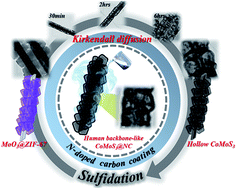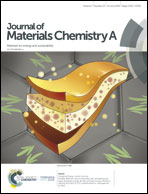A MOF-mediated strategy for constructing human backbone-like CoMoS3@N-doped carbon nanostructures with multiple voids as a superior anode for sodium-ion batteries†
Abstract
Nanostructured, multicomponent metal sulfides have recently attracted much attention as anode materials for high-performance sodium ion batteries (SIBs). Therefore, a simple strategy for constructing rationally designed multicomponent metal sulfide-based nanostructures is needed. Herein, we propose a metal–organic framework-based (MOF) strategy to construct human backbone-like CoMoS3 nanostructures with multiple voids as high-performance SIB anodes. This strategy involves conformal coating of a Co-based MOF onto the surface of MoO3 nanobelts, followed by sulfidation of the hybrids. We explore not only the optimized conditions for uniform ZIF-67 coating on the MoO3 nanobelts, but also the transformation mechanism of the MoO3@ZIF-67 hybrids into CoMoS3 nanobackbones with multiple voids. To further improve the structural stability, the nanobackbones were coated with polydopamine and then thermally treated under inert conditions, resulting in the formation of CoMoS3@N-doped carbon (NC) nanobackbones. Benefiting from their unique structural design, conductive carbon shells, and synergistic effects between multiple components, the CoMoS3@NC nanobackbones exhibit enhanced electrochemical performance when tested as anode materials for SIBs. They deliver a reversible capacity of 411 mA h g−1 for 300 cycles at a current density of 2 A g−1, and an excellent rate performance of 349 mA h g−1 at a current density of 10 A g−1. This simple strategy can be used to fabricate other multicomponent metal sulfide/carbon composites with multiple voids, which can be used for various applications.



 Please wait while we load your content...
Please wait while we load your content...